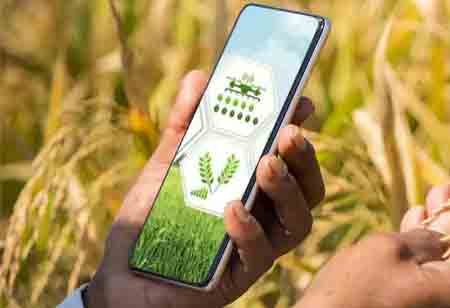Thank you for Subscribing to Agri Business Review Weekly Brief
Will Agriculture's Future Rely on Smart Farming?
As the population grows, there is a rising demand for food, and as urbanisation expands, more land is being taken.

By
Agri Business Review | Tuesday, April 04, 2023
Stay ahead of the industry with exclusive feature stories on the top companies, expert insights and the latest news delivered straight to your inbox. Subscribe today.
Historically, agricultural facilities invested immense amounts of time, money, and effort in ordering, unloading, storing, planting, monitoring, cultivating, and ultimately, harvesting crops. New smart farming technologies can offer new ways to streamline the workflow, improve operations, and by doing so, create more robust businesses.
FREMONT, CA: As the population grows, there is a rising demand for food, and as urbanisation expands, more land is being taken. To survive in the future, agricultural businesses must operate with novel and modified methods. Farmers today have that option thanks to emerging technology, which is referred to as "Smart Farming," as they attempt to carry on the agricultural way of life to the next generation while overcoming previously unheard-of obstacles. Farmers' profits are declining as a consequence. Local farms, some of which are located in the most fertile regions of the globe, are declining. As a result, starting a profitable business has grown more difficult, and farmers now need to discover ways to work more effectively rather than simply harder.
The ordering, unloading, storing, planting, observing, cultivating, and eventually harvesting of crops required a great deal of time, money, and effort in the past on the part of agricultural facilities. A more streamlined workflow, improved operations, and stronger companies can all be facilitated by new smart farming technologies.
The keystone of this change is the internet of things (IoT). As the farmer's eyes and ears, intelligent sensors are positioned all over a field to gather data on crop and equipment performance. The capacity of IoT technology to expand visibility to new endpoints is one of its most valuable features. Farmers are better able to manage their operations and gain more insight into them when they have access to real-time monitoring and analytics tools.
Here are a few ways that smart farming enhances agrarian businesses and will do so going forward:
Monitoring crop growth: IoT in the agricultural sector aids producers in enhancing the fertility of the soil and the quality of their crops. Nutrient density data is gathered by sensors so that producers can modify their fertiliser application rates. Regulating pesticides can be used to get rid of an invasion if there are any indications of one. Data-driven agriculture essentially gives farms more control. Receiving information enables activities to be adjusted in response to the current situation, making crop cycle management easier, increasing productivity, and promoting crop development.
Improving greenhouse operations: In addition to enhancing visibility, greenhouse IoT devices automate previously manual tasks, making the entire process more effective and automated. Real-time data, including air pressure, humidity, temperature, light levels, and soil conditions, is collected and transmitted by them. Several issues can be monitored through email or SMS alerts, including water usage. Modern devices are capable of automatic adjustments. The cost-effectiveness, accuracy, and operational performance of the procedures all rise.
Tracking water use: By monitoring how much water is being used and how much is still available, agricultural IoT enables farmers to watch water tank levels in real time. Smartphones provide simple reports that describe patterns and, in some cases, even offer advice. Farmers can modify water use as necessary to improve the effectiveness and cost-effectiveness of watering.
Farmers can keep an eye on their lands, vehicles, and other properties with the help of IoT. Farmers want to reduce downtime because the equipment is essential to everyday operations. This offers a view of the device's effectiveness, which is updated as the apparatus is used. They receive the managerial insights they require from advanced data analytics. Artificial intelligence and machine learning use metrics like vibration analysis, oil analysis, and thermal imaging to determine an asset's usual efficiency and wear and tear. Complex algorithms are used by predictive maintenance models to determine when an object needs to be maintained, repaired, or replaced. These observations are made before the devices cease working, rather than during or after, which prevents any hiccups in the farms' operations. Longer machinery lifecycles, less downtime, and more efficient workers are a few advantages.
Livestock monitoring takes a lot of work, time, and money. In the past, individuals manually examined animals to search for signs of illness or damage. The procedure was expensive, incredibly unpredictable, and ineffective. By tracking an animal's temperature, blood pressure, heart rate, and other vital signs, IoT solutions eliminate all room for guesswork when deciding its health. Near real-time wireless transmission of the data to a program.
The following data is then accessible to farmers via smart devices: They can monitor the condition and position of every animal in their herds from any location. One can find out when breeding season is at its busiest. If a metric is outside of the expected limit, alerts are sent. Recognizing preferred feeding areas is simple
Farmers are given the ability to create more individualised strategies by implementing smart agricultural technology, and this capability alters the dynamic between customers and retailers. While keeping the focus on developing new lines of their products, farmers can concentrate on customers who are interested in sustainability and eco-friendly food. Then they can raise the prices for their products, increase sales, and build a better company. Smart farming technology gives companies new means to boost agricultural productivity, which also lowers expenses and boosts revenue. In other words, smart farming technology is crucial for the advancement of contemporary agriculture and will ensure the sustainability of the agricultural sector in the future.





